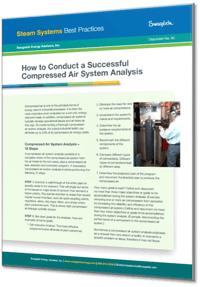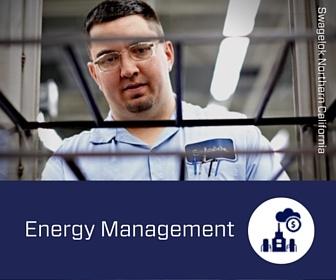Share this
12 Steps to a Successful Compressed Air System Analysis
by Jeff Hopkins on 11/3/17 9:00 AM
These systems typically develop operational issues and leaks as they age

With a thorough analysis, it is not unusual to eliminate up to 22 percent of compressed air energy costs. Download the complete best practice to learn more »
Compressed Air System Analysis in 12 Steps
A compressed air system analysis consists of a complete review of the compressed air system from
the air intake to the end users, plus a compressed air leak detection and correction program. A successful
compressed air system analysis involves performing the following 12 steps.
1. Take a walk
Walk through the entire plant or specific areas to be reviewed. This will single out some of the issues or major areas of concern that demand a higher priority. Pay special attention to quick coupling points, regulators, oilers, drip traps, filters, and areas where plant personnel work.
2. Set goals
Set a few major goals (no more than three) such as removing one or more air compressors from operation. Also, set a few minor goals such as documenting the performance of a component in the compressed air system.
3. Who will do it?
Will you use in-house staff or a third party? There are benefits and detriments to each option.
Your own employees are more likely to know the compressed air system, but they may not have all the specific skills and equipment. An outside contractor can furnish the necessary labor and testing equipment, leaving your staff free to concentrate on their core jobs. But outsiders won't know the facility layout or operating conditions. It helps to have an insider work with an outsourced team.
4. Get management on board
You may need special funding for the project. If you've already completed the first three steps, you'll be able to provide management with the cost of compressed air operations, your expected goals, and how you plan to accomplish them.
5. Benchmark
Measure the current performance so that you can show that your program succeeded. Review the standard operating procedures for the compressor operation. If SOPs do not exist, write them.
6. Pick a method
There are three basic ways to find leaks. One is the human ear. It's instantly available, but not always great for pinpointing the leak area. Background noise gets in the way too. Another option is a liquid detector. The third is ultrasound equipment.
With a thorough analysis, it is not unusual to eliminate up to 22 percent of compressed air energy costs.
7. Prioritize repairs
How small of a leak are you willing to fix? Some leaks may require lines to be shut down.
8. Prioritize testing
Think about ease of access to various parts of the system, where equipment is concentrated, and your ability to document cost savings.
9. Determine documentation
How will you measure success? If the report is vague, it will be hard to get others to take it seriously and continue the program.
10. Find a qualified contractor
If you are using an outside contractor, put together a checklist of things to look for. That can include a company's ability to do all the work itself, its safety record, and its references. Also, make sure the company can meet your schedule not only for the analysis itself, but also for delivering a report.
11. Analyze and make corrections
Now it's finally time to do the main job. But don't stop there. Have maintenance personnel stay on top of the system by identifying and repairing leaks once a month or at least every six weeks.
12. Spread the word
Market the program’s results to the plant. This will keep the program moving forward, and ensure continuing success.
A more detailed look
For a more detailed look at all 12 steps, How to Conduct a Successful Compressed Air System Analysis is available as a free, illustrated, four-page PDF. Click here to access the complete best practice.
Download it, read it, then get ready to start saving some money on your compressed air system.
additional resources
get in touch
In a hurry or have a question? Please click here to get in touch - we respond fast! Or call 510-933-6200.
Share this
- Archive (465)
- Assembly Services (207)
- About (100)
- Seal Support Systems (96)
- Best Practices (88)
- Training Services (74)
- Fittings (51)
- Semiconductor Applications (49)
- Hoses and Flexible Tubing (47)
- Regulators (44)
- Tubing (42)
- Grab Sampling Systems (32)
- Sampling Systems (32)
- Gas Systems (30)
- Services (30)
- Downloads (29)
- Valves (24)
- Application Support (18)
- Orbital Welding (17)
- Case Studies (13)
- Steam Systems (13)
- Frequently Asked Questions (12)
- Tools (12)
- Measurement Devices (7)
- Subsystems (6)
- Thermal Management (6)
- September 2023 (1)
- August 2023 (2)
- June 2023 (1)
- March 2023 (3)
- February 2023 (3)
- January 2023 (4)
- December 2022 (4)
- November 2022 (4)
- October 2022 (4)
- September 2022 (1)
- August 2022 (3)
- July 2022 (2)
- June 2022 (4)
- May 2022 (1)
- April 2022 (2)
- March 2022 (1)
- February 2022 (2)
- January 2022 (3)
- December 2021 (1)
- November 2021 (6)
- October 2021 (6)
- September 2021 (8)
- August 2021 (4)
- July 2021 (3)
- June 2021 (6)
- May 2021 (6)
- April 2021 (7)
- March 2021 (5)
- February 2021 (4)
- January 2021 (6)
- December 2020 (5)
- November 2020 (6)
- October 2020 (6)
- September 2020 (8)
- August 2020 (7)
- July 2020 (8)
- June 2020 (8)
- May 2020 (6)
- April 2020 (9)
- March 2020 (7)
- February 2020 (10)
- January 2020 (21)
- December 2019 (23)
- November 2019 (21)
- October 2019 (22)
- September 2019 (21)
- August 2019 (22)
- July 2019 (23)
- June 2019 (20)
- May 2019 (23)
- April 2019 (22)
- March 2019 (21)
- February 2019 (20)
- January 2019 (21)
- December 2018 (14)
- November 2018 (19)
- October 2018 (23)
- September 2018 (17)
- August 2018 (29)
- July 2018 (11)
- June 2018 (6)
- May 2018 (5)
- April 2018 (4)
- March 2018 (5)
- February 2018 (3)
- January 2018 (3)
- December 2017 (2)
- November 2017 (4)
- October 2017 (3)
- September 2017 (2)
- August 2017 (6)
- July 2017 (4)
- June 2017 (4)
- May 2017 (4)
- April 2017 (3)
- March 2017 (4)
- February 2017 (3)
- January 2017 (3)
- December 2016 (3)
- November 2016 (3)
- October 2016 (3)
- September 2016 (5)
- August 2016 (5)
- July 2016 (4)
- June 2016 (5)
- May 2016 (3)
- April 2016 (4)
- March 2016 (5)
- February 2016 (11)
- January 2016 (1)
- December 2015 (3)
- November 2015 (4)
- October 2015 (3)
- September 2015 (4)
- August 2015 (4)
- July 2015 (8)
- June 2015 (5)
- May 2015 (3)
- April 2015 (4)
- March 2015 (4)
- February 2015 (3)
- January 2015 (4)
- December 2014 (2)
- November 2014 (3)
- October 2014 (4)
- September 2014 (4)
- August 2014 (4)
- July 2014 (5)
- June 2014 (4)
- May 2014 (4)
- April 2014 (5)
- March 2014 (4)
- February 2014 (3)
- January 2014 (4)
- December 2013 (5)
- November 2013 (3)
- October 2013 (4)
- September 2013 (3)
- August 2013 (5)
- July 2013 (5)
- June 2013 (5)
- May 2013 (3)
- April 2013 (6)
- March 2013 (4)
- February 2013 (4)
- January 2013 (8)
- December 2012 (4)
- November 2012 (6)
- October 2012 (6)
- September 2012 (4)
- August 2012 (4)
- July 2012 (4)
- June 2012 (4)

.webp?width=210&height=70&name=StickyLogo%20(5).webp)
